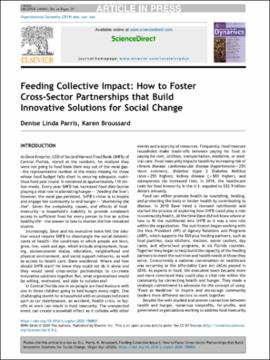| dc.description.abstract | As Dave Krepcho, CEO of Second Harvest Food Bank (SHFB) of Central Florida, stared at the numbers, he realized they were not going to food bank their way out of the meal gap—the representative number of the meals missing for those whose food budget falls short in securing adequate, nutritious food year round. It remained at approximately 110 million meals. Every year SHFB has increased food distribution playing a vital role in alleviating hunger— ‘feeding the line’; however, the meal gap persisted. SHFB’s vision is to inspire and engage the community to end hunger— ‘shortening the line’. Given the complexity, causes, and effects of food insecurity—a household’s inability to provide consistent access to sufficient food for every person to live an active healthy life—the answer to how to shorten the line remained elusive.
Increasingly, Dave and his executive team felt the solution would require SHFB to disentangle the social determinants of health—the conditions in which people are born, grow, live, work and age, which include employment, housing, socioeconomic status, education, neighborhood and physical environment, and social support networks, as well as access to health care. Dave wondered: Where and how should SHFB start? He knew they could not do it alone and they would need cross-sector partnerships to co-create innovative solutions together. But, what organizations would be willing, motivated, and able to collaborate?
Dave and his executive team began to reach out to healthcare industry leaders asking: what if we worked alongside each other instead of separately? Guiding their conversations was a goal of fostering collective impact, which was first defined by Kania and Kramer (2011) in their article published Stanford Social Innovation Review as “the commitment of a group of important actors from different sectors to a common agenda for solving a specific social problem” (p. 36). With each conversation they intentionally used the word ‘we’, emphasized the shared value of “Food as Medicine’, and encouraged collaborative exploration. The open-ended nature of the conversations focused on listening and ideation. As champions of collective impact, SHFB invested in values, focused on facilitating rather than owning the process, and embraced continuous iterative learning.
The assumption is institutional change, which refers to changes in the general constitution of an entire class of organizations, is best led by governments and corporations as they have the infrastructure and resources to enact change, whereas nonprofits have limited bandwidth and capacity to expand their business operations. Nevertheless, SHFB—an established community nonprofit with a strong financial foundation and an entrepreneurial organizational culture focused on innovating for tomorrow—began to play the vital role of fostering cross-sector partnerships to build innovative solutions for social change. | en_US |

